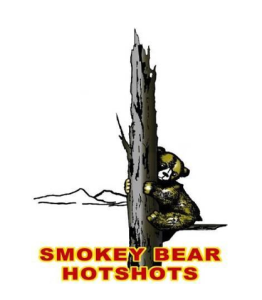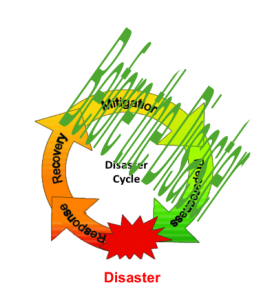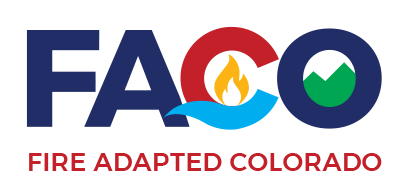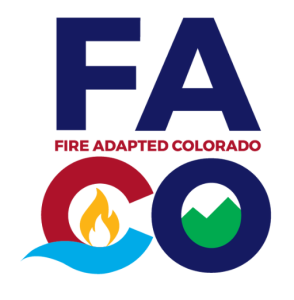Not if, but When
Those of us who are passionate about wildfire mitigation, preparedness, response, and recovery have heard it time and time again, the phrase it’s not if, but when. It means that a thing is certain to happen, but you don’t know when. As wildfire resilience leaders, we are on the front lines of knowing that destructive wildfires will happen, it’s inevitable, that it’s going to come to be and there’s no doubt about it. The only question is when it will happen in your community.
As the week started, Fire Adapted Colorado staff were among those hearing the breaking news out of Ruidoso New Mexico: Two new, fast-moving fire starts, the South Fork Fire and Salt Fire, burning on the Mescalero Apache Indian Reservation, US Forest Service land, and the areas around the Village of Ruidoso, spanning Otero and Lincoln Counties. Mandatory GO evacuation orders for Ruidoso Downs, the Village of Ruidoso, and outlying areas and subdivisions remain in effect at the time of this writing (June 19, 2024).
Early reports include zero containment of the fires, the loss of approximately 1,400 structures, with an estimated 8,000 people evacuated from the area, and one initial fatality that has been reported. (Numbers that are expected to grow.)
The Southwest Complex Incident Management (CIM) Team 5 assumed command Wednesday, June 19, at 6 a.m, as the fires remain 0% contained. The Village of Ruidoso has a robust fire information hub, as well as incident updates that can be found on InciWeb.
 Five Smokey Bear Hotshot crew members who were working the fires are among those who lost everything.
Five Smokey Bear Hotshot crew members who were working the fires are among those who lost everything.
“The Hotshot crew for The Lincoln NF are the Smokey Bear Hotshots. A well-known and loved crew of hard-working men and women. They were out working this fire when 5 of the crew learned their homes had been burned to the ground. Imagine that. While out on a fire that is just purely wicked, no controlling it, you learn your home and everything you own is just gone. And you’re still at work…”
Michelle Levy |SOURCE: The Hotshot Wake Up, Jun 19, 2024
A GoFundMe page has been established to Help Rebuild Lives of Smokey Bear Hotshots.
New Mexico Governor Michelle Lujan Grisham also announced on Tuesday that the All Together NM Fund is collecting donations for New Mexicans impacted by wildfires burning across the state. The funds will be distributed to affected New Mexico communities in coordination with local organizations for emergency shelter, food and water distribution, and access to medical support.
Donations management is an important aspect of the preparedness phase of the emergency management cycle, not to be overlooked. Preparedness is a continuous cycle of planning, organizing, training, equipping, exercising, evaluating, and taking corrective action. The outpouring of donations following a disaster can bring out the best in people. Sadly, scammers will also prey on the compassion of donors in the fallout of natural disasters.
Preplanning donations management and messaging before a disaster is an important component of both communications and recovery/resiliency planning. Avoiding a “second disaster” of spontaneous donations that flood supply chains with unwanted or low-priority goods that slow down the distribution of supplies most needed by disaster survivors, which can overwhelm response agencies is a high priority for response organizations. The challenges of sorting and distributing donations as well as disposing of inappropriate donations can be so bad that it is sometimes referred to as the disaster that follows the disaster. SOURCE: Natural Hazards Center.
As the 2024 wildfire season unfolds, Grant Webster, of the WiRē Research Team has just released the preliminary findings of a study using WiRē data to study the relationship between mitigation and evacuation preparedness, focusing on the two phases of the disaster cycle that happen before a wildfire occurs: Mitigation and Preparedness.
 A recent Wildfire Research Analysis of household surveys [1] about wildfire risk and mitigation actions confirms what many have observed through experience. Community wildfire activities, including talking with your neighbors about wildfire, participating in community wildfire preparedness events, and meeting with wildfire professionals are strongly correlated with residents taking evacuation preparedness actions (see slidedeck – slide 16).
A recent Wildfire Research Analysis of household surveys [1] about wildfire risk and mitigation actions confirms what many have observed through experience. Community wildfire activities, including talking with your neighbors about wildfire, participating in community wildfire preparedness events, and meeting with wildfire professionals are strongly correlated with residents taking evacuation preparedness actions (see slidedeck – slide 16).
Through a FAC Neighborhood Ambassador Approach, Firewise Communities, and the many other boots-on-the-ground efforts of Colorado’s place-based organizations, mitigation professionals are working to empower residents to be catalysts for wildfire adaptation in their neighborhoods. The research indicates that households who do more mitigation actions are those who are more likely to be prepared to evacuate. Joint messaging by Emergency Management and place-based mitigation organizations could benefit one another.
We recently reported on Wildfire Community Preparedness Day projects awarded through FACO, providing financial awards to 14 projects, including installing address signage, an evacuation drill, HIZ evaluation, and vegetation management around homes and condominiums, roadside thinning projects, chipping projects, and a fire fair. It’s a safe bet to say that these communities are also more likely prepared in the event of an evacuation than other neighborhoods in their communities.
In addition to the initial ways to help disaster affected individuals and communities shared above or other official donation recommendations shared in official press releases, the best way to help reduce the impacts of community firestorms is to prepare yourself, your family, and your community so when the time comes, you’re READY!
[1]The WiRē data set for findings on evacuation planning, (slides 9,11, 17) included 6,100 households, while the evacuation preparedness activities data set included 2,300 households, (slides 10,12,14, 16).

